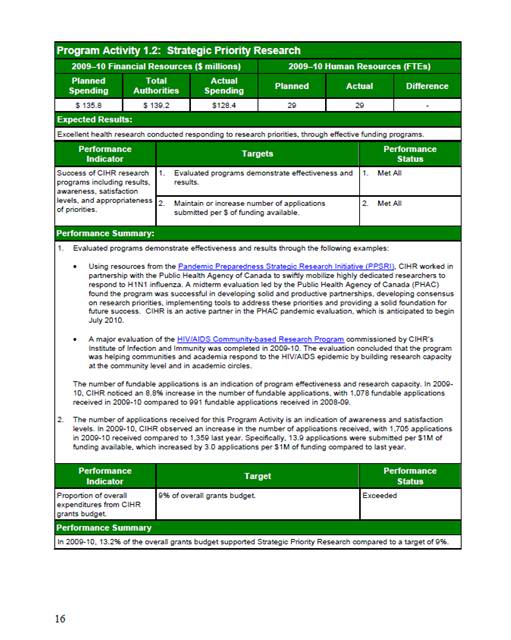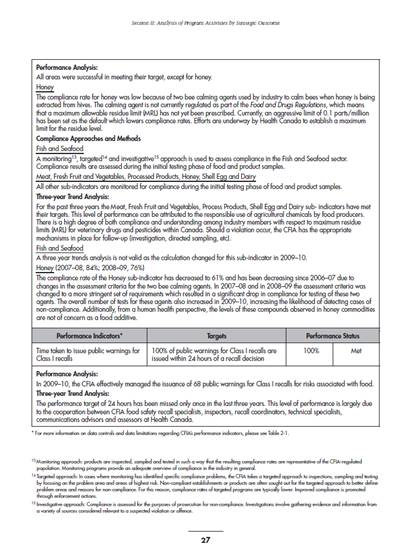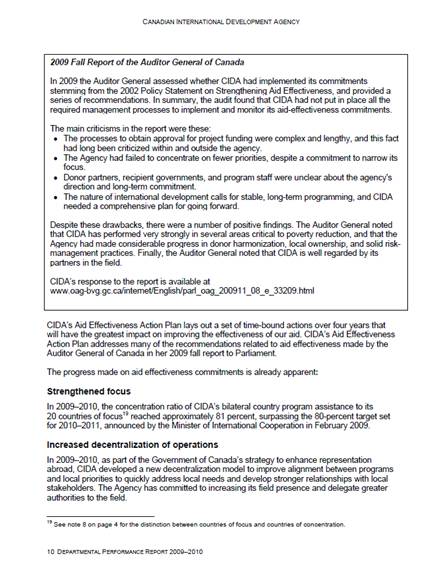Common menu bar links
Breadcrumb Trail
ARCHIVED - Performance Reporting: Good Practices Handbook 2011
 This page has been archived.
This page has been archived.
Archived Content
Information identified as archived on the Web is for reference, research or recordkeeping purposes. It has not been altered or updated after the date of archiving. Web pages that are archived on the Web are not subject to the Government of Canada Web Standards. As per the Communications Policy of the Government of Canada, you can request alternate formats on the "Contact Us" page.
Use the MRRS as the basis of reporting
For performance information, both financial and non-financial, the MRRS establishes a common approach for its collection, management, and reporting. The MRRS also provides a standard basis for the activities of planning, managing, and reporting. It is a logical organization of the programs being delivered (described by the PAA) and the benefits to Canadians that departments are working to achieve (i.e., strategic outcomes). A key to the success of the Policy on Management, Resources and Results Structures is the development of systems for producing credible and reliable performance information as indicated in the Performance Measurement Framework (PMF).
The performance story presented in the report should be framed within the context of program activities and how they contribute to the progress made on achieving strategic outcomes. Reporting on a key sub-activity is acceptable when discussed within the context (and in support) of reporting on program activity performance.
Reporting on the basis of the MRRS enables parliamentarians to follow the story—from plans to actual spending to actual results.
Good practice: Use the MRRS as the basis of reporting.
Why is the following a good practice? The overall basis of reporting is the PAA. The agency includes program activity performance indicators and targets from the agency’s approved MRRS. Performance indicators and targets measure progress toward the success of the program activity.
Good practice example: Canadian Institutes of Health Research DPR 2009–10

Good practice (example 2): Use the MRRS as the basis of reporting (trend analysis).
Why is the following a good practice? The DPR provides a rigorous performance analysis based on the supporting performance measurement framework (pages 27 and 28), including three-year trend analyses.
Good practice example: Canadian Food Inspection Agency DPR 2009–10

Report positive and negative aspects of performance
Balanced reporting enhances the credibility of reporting. Moreover, reporting on both the positive and negative aspects of performance meets the intention of public performance reporting, i.e., to provide the necessary information for scrutiny and decision making.
Performance information is not fairly presented when the information is limited to successes and minimizes, or even avoids, discussion of matters that did not unfold as planned. In order for reporting to be fair, key information must not be omitted. When discussing results achieved, departments should discuss what went according to plan as well as cases where things did not go according to plan but risks were mitigated. Departments should also discuss results that were not achieved, noting how and why plans were not implemented as intended. It is also important to include explanations of how the department uses both positive and negative results to make adjustments and improvements toward achieving its strategic outcomes. Findings that emerge from evaluations are important sources of information in framing these discussions.
Good practice: Report positive and negative aspects of performance.
Why is the following a good practice? The DPR’s discussion of performance exhibits a transparent approach to reporting. Up front is a discussion (page 10) of shortfalls and results of an audit.
Good practice example: Canadian International Development Agency DPR 2009–10

